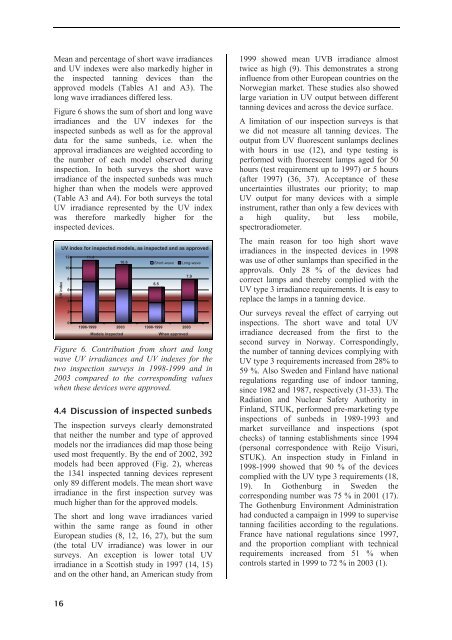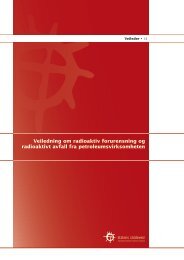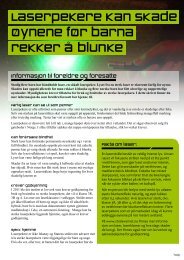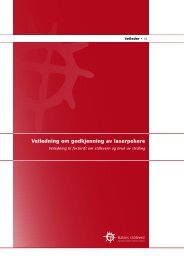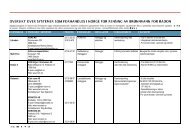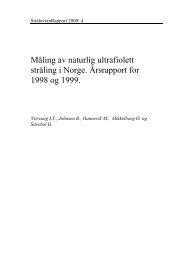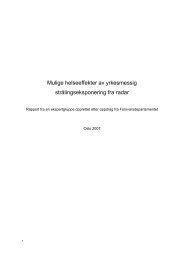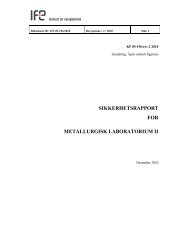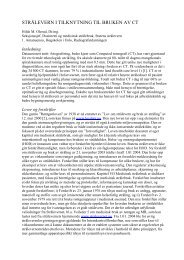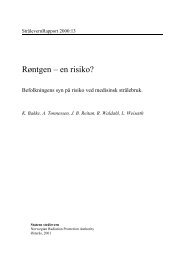Indoor Tanning in Norway - Statens strålevern
Indoor Tanning in Norway - Statens strålevern
Indoor Tanning in Norway - Statens strålevern
Create successful ePaper yourself
Turn your PDF publications into a flip-book with our unique Google optimized e-Paper software.
Mean and percentage of short wave irradiances<br />
and UV <strong>in</strong>dexes were also markedly higher <strong>in</strong><br />
the <strong>in</strong>spected tann<strong>in</strong>g devices than the<br />
approved models (Tables A1 and A3). The<br />
long wave irradiances differed less.<br />
Figure 6 shows the sum of short and long wave<br />
irradiances and the UV <strong>in</strong>dexes for the<br />
<strong>in</strong>spected sunbeds as well as for the approval<br />
data for the same sunbeds, i.e. when the<br />
approval irradiances are weighted accord<strong>in</strong>g to<br />
the number of each model observed dur<strong>in</strong>g<br />
<strong>in</strong>spection. In both surveys the short wave<br />
irradiance of the <strong>in</strong>spected sunbeds was much<br />
higher than when the models were approved<br />
(Table A3 and A4). For both surveys the total<br />
UV irradiance represented by the UV <strong>in</strong>dex<br />
was therefore markedly higher for the<br />
<strong>in</strong>spected devices.<br />
UV <strong>in</strong>dex<br />
16<br />
UV <strong>in</strong>dex for <strong>in</strong>spected models, as <strong>in</strong>spected and as approved<br />
12<br />
10<br />
8<br />
6<br />
4<br />
2<br />
0<br />
11.4<br />
10.6<br />
Short-wave Long-wave<br />
1998-1999 2003 1998-1999 2003<br />
6.5<br />
Models <strong>in</strong>spected When approved<br />
Figure 6. Contribution from short and long<br />
wave UV irradiances and UV <strong>in</strong>dexes for the<br />
two <strong>in</strong>spection surveys <strong>in</strong> 1998-1999 and <strong>in</strong><br />
2003 compared to the correspond<strong>in</strong>g values<br />
when these devices were approved.<br />
4.4 Discussion of <strong>in</strong>spected sunbeds<br />
The <strong>in</strong>spection surveys clearly demonstrated<br />
that neither the number and type of approved<br />
models nor the irradiances did map those be<strong>in</strong>g<br />
used most frequently. By the end of 2002, 392<br />
models had been approved (Fig. 2), whereas<br />
the 1341 <strong>in</strong>spected tann<strong>in</strong>g devices represent<br />
only 89 different models. The mean short wave<br />
irradiance <strong>in</strong> the first <strong>in</strong>spection survey was<br />
much higher than for the approved models.<br />
The short and long wave irradiances varied<br />
with<strong>in</strong> the same range as found <strong>in</strong> other<br />
European studies (8, 12, 16, 27), but the sum<br />
(the total UV irradiance) was lower <strong>in</strong> our<br />
surveys. An exception is lower total UV<br />
irradiance <strong>in</strong> a Scottish study <strong>in</strong> 1997 (14, 15)<br />
and on the other hand, an American study from<br />
7.9<br />
1999 showed mean UVB irradiance almost<br />
twice as high (9). This demonstrates a strong<br />
<strong>in</strong>fluence from other European countries on the<br />
Norwegian market. These studies also showed<br />
large variation <strong>in</strong> UV output between different<br />
tann<strong>in</strong>g devices and across the device surface.<br />
A limitation of our <strong>in</strong>spection surveys is that<br />
we did not measure all tann<strong>in</strong>g devices. The<br />
output from UV fluorescent sunlamps decl<strong>in</strong>es<br />
with hours <strong>in</strong> use (12), and type test<strong>in</strong>g is<br />
performed with fluorescent lamps aged for 50<br />
hours (test requirement up to 1997) or 5 hours<br />
(after 1997) (36, 37). Acceptance of these<br />
uncerta<strong>in</strong>ties illustrates our priority; to map<br />
UV output for many devices with a simple<br />
<strong>in</strong>strument, rather than only a few devices with<br />
a high quality, but less mobile,<br />
spectroradiometer.<br />
The ma<strong>in</strong> reason for too high short wave<br />
irradiances <strong>in</strong> the <strong>in</strong>spected devices <strong>in</strong> 1998<br />
was use of other sunlamps than specified <strong>in</strong> the<br />
approvals. Only 28 % of the devices had<br />
correct lamps and thereby complied with the<br />
UV type 3 irradiance requirements. It is easy to<br />
replace the lamps <strong>in</strong> a tann<strong>in</strong>g device.<br />
Our surveys reveal the effect of carry<strong>in</strong>g out<br />
<strong>in</strong>spections. The short wave and total UV<br />
irradiance decreased from the first to the<br />
second survey <strong>in</strong> <strong>Norway</strong>. Correspond<strong>in</strong>gly,<br />
the number of tann<strong>in</strong>g devices comply<strong>in</strong>g with<br />
UV type 3 requirements <strong>in</strong>creased from 28% to<br />
59 %. Also Sweden and F<strong>in</strong>land have national<br />
regulations regard<strong>in</strong>g use of <strong>in</strong>door tann<strong>in</strong>g,<br />
s<strong>in</strong>ce 1982 and 1987, respectively (31-33). The<br />
Radiation and Nuclear Safety Authority <strong>in</strong><br />
F<strong>in</strong>land, STUK, performed pre-market<strong>in</strong>g type<br />
<strong>in</strong>spections of sunbeds <strong>in</strong> 1989-1993 and<br />
market surveillance and <strong>in</strong>spections (spot<br />
checks) of tann<strong>in</strong>g establishments s<strong>in</strong>ce 1994<br />
(personal correspondence with Reijo Visuri,<br />
STUK). An <strong>in</strong>spection study <strong>in</strong> F<strong>in</strong>land <strong>in</strong><br />
1998-1999 showed that 90 % of the devices<br />
complied with the UV type 3 requirements (18,<br />
19). In Gothenburg <strong>in</strong> Sweden the<br />
correspond<strong>in</strong>g number was 75 % <strong>in</strong> 2001 (17).<br />
The Gothenburg Environment Adm<strong>in</strong>istration<br />
had conducted a campaign <strong>in</strong> 1999 to supervise<br />
tann<strong>in</strong>g facilities accord<strong>in</strong>g to the regulations.<br />
France have national regulations s<strong>in</strong>ce 1997,<br />
and the proportion compliant with technical<br />
requirements <strong>in</strong>creased from 51 % when<br />
controls started <strong>in</strong> 1999 to 72 % <strong>in</strong> 2003 (1).


